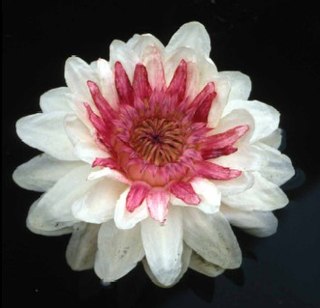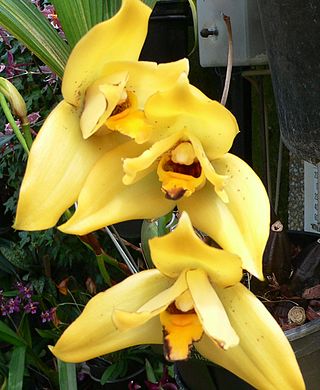
Orchids are plants that belong to the family Orchidaceae, a diverse and widespread group of flowering plants with blooms that are often colourful and fragrant. Orchids are cosmopolitan plants that are found in almost every habitat on Earth except glaciers. The world's richest diversity of orchid genera and species is found in the tropics.

Cattleya is a genus of orchids from Costa Rica south to Argentina. The genus is abbreviated C in trade journals.

Ulmus pumila, the Siberian elm, is a tree native to Asia. It is also known as the Asiatic elm and dwarf elm, but sometimes miscalled the 'Chinese elm'. U. pumila has been widely cultivated throughout Asia, North America, Argentina, and southern Europe, becoming naturalized in many places, notably across much of the United States.
The hybrid elm cultivar Ulmus × intermedia 'Coolshade' is an American hybrid cultivar cloned from a crossing of the Slippery, or Red, Elm Ulmus rubra and the Siberian Elm Ulmus pumila at the Sarcoxie Nurseries, Sarcoxie, Missouri, in 1946. At Arnold Arboretum, where there was a specimen, herbarium material was labelled Ulmus pumila 'Coolshade'.
The Siberian Elm cultivar Ulmus pumila 'Park Royal' is a cold-hardy selection raised by the Sheridan Nursery, Toronto, Ontario, Canada.

The hybrid elm cultivar Ulmus 'Den Haag' is a Dutch development derived from a chance crossing of the Siberian Elm cultivar Ulmus pumila 'Pinnato-ramosa' and the Belgian Elm Ulmus × hollandica 'Belgica'. S. G. A. Doorenbos (1891-1980), Director of Public Parks in The Hague, finding that seeds he had sown in 1936 from the Zuiderpark 'Pinnato-ramosa' had hybridized with the local 'Belgica', selected six for trials. The best was cloned and grafted on 'Belgica' rootstock as 'Den Haag'; it was planted first in that city, then released to nurseries elsewhere in the Netherlands. The other five were also planted in The Hague.

The Siberian Elm cultivar Ulmus pumila 'Pendula' is from northern China, where it is known as Lung chao yü shu. It was classified by Frank Meyer in Fengtai in 1908, and introduced to the United States by him from the Peking Botanical Garden as Weeping Chinese Elm. The USDA plant inventory record (1916) noted that it was a "rare variety even in China". It was confirmed as an U. pumila cultivar by Krüssmann (1962).
The hybrid elm cultivar Ulmus × intermedia 'Rosehill' is an American hybrid cultivar originally raised by the Rose Hill Nurseries of Kansas City, Missouri, as Ulmus 'Rose Hill', without species names, from a selection of Ulmus pumila × Ulmus rubra seedlings made in 1951.
Ulmus × arbusculaE. Wolf [: "bushy" ] is a putative hybrid of Ulmus scabra and Ulmus pumila raised from seed collected from a large wych elm in the St. Petersburg Botanic Garden in 1902. A similar crossing was cloned ('FL025') by the Istituto per la Protezione delle Piante (IPP), Florence, as part of the Italian elm breeding programme circa 2000.

The Siberian elm cultivar Ulmus pumila 'Pinnato-ramosa' was raised by Georg Dieck, as Ulmus pinnato-ramosa, at the National Arboretum, Zöschen, Germany, from seed collected for him circa 1890 in the Ili valley, Turkestan by the lawyer and amateur naturalist Vladislav E. Niedzwiecki while in exile there. Litvinov (1908) treated it as a variety of Siberian elm, U. pumilavar.arborea but this taxon was ultimately rejected by Green, who sank the tree as a cultivar: "in modern terms, it does not warrant recognition at this rank but is a variant of U. pumila maintained and known only in cultivation, and therefore best treated as a cultivar". Herbarium specimens confirm that trees in cultivation in the 20th century as U. pumilaL. var. arboreaLitv. were no different from 'Pinnato-ramosa'.

The Flora of Colombia is characterized by over 32,000 species of green plants.

The term grex, derived from the Latin noun grex, gregis, meaning 'flock', has been expanded in botanical nomenclature to describe hybrids of orchids, based solely on their parentage. Grex names are one of the three categories of plant names governed by the International Code of Nomenclature for Cultivated Plants; within a grex the cultivar group category can be used to refer to plants by their shared characteristics, and individual orchid plants can be selected and named as cultivars.

Cattleya mossiae, commonly known as the Easter orchid, is a species of labiate Cattleya orchid. The white-flowered form is sometimes known as Cattleya wagneri. The diploid chromosome number of C. mossiae has been determined as 2n = 40. The haploid chromosome number has been determined as n = 20.

Cattleya elongata, the "cattleya with the elongated stalk", is an orchid species in the genus Cattleya endemic to the campo rupestre vegetation in northeastern Brazil.

Ulmus pumila, or 'Poort Bulten,' is a Siberian elm cultivar that hails from Arboretum Poort Bulten in Losser, Netherlands. This tree was for many years mistaken for Planera aquatica or 'water elm' and commercially propagated under that name.
C. spectabilis may refer to:

Cattleya × elegans is a hybrid orchid in the subtribe Laeliinae. It is a pseudobulb epiphyte. Its formula hybridae is Cattleya purpurata Van den Berg (2008) × Cattleya tigrina A.Rich. (1848). It is found in South and South-East Brazil.
Ulmus × intermediaElowsky is a natural hybrid elm occurring across Nebraska and several other Midwestern states, derived from the crossing of Ulmus rubra and Ulmus pumila. As Red Elm U. rubra is far less fertile, and highly susceptible to Dutch elm disease (:DED), it could eventually be hybridized out of existence by U. × intermedia. The hybrid was first reported from the wild in the Chicago region in 1950 and was provisionally named U. × nothaWilhelm & Ware in 1994.
The Siberian Elm cultivar Ulmus pumila 'Zhonghua Jinye' is an introduction from China.
Summertime is an Italian drama streaming television series produced by Cattleya that premiered on Netflix on 29 April 2020. The series stars Rebecca Coco Edogamhe, Ludovico Tersigni, and Amanda Campana. It takes place at a small town on the Adriatic coast, Cesenatico, and revolves around Summer and her love life. It is inspired by Three Meters Above the Sky by Federico Moccia. After the premiere of the first season, Netflix renewed the series for a second season. In 2021, Netflix reported that Summertime was renewed for a third and final season.












